Begonias
BackBegonias come in all shapes and sizes and are highly prized for their brightly coloured flowers and patterned leaves. They are prolific and long flowering plants that happily grow in garden beds as well pots and hanging baskets.
Begonias mostly originate from tropical and subtropical areas but don’t let that put you off as many are extremely adaptable to other growing conditions. Regardless of where you live there’s a begonia that will thrive for you.
Types of Begonias
With over 1,500 species of begonias as well as many hybrids and cultivars it can get very confusing talking about begonias. To make it a bit easier we’ve put the most common types into a few basic groups:
Bedding begonias (Begonia semperflorens) – these are small, sun hardy plants that can be grown anywhere in Australia. They have shiny green or bronze coloured waxy leaves and come with white, red or pink flowers. They flower continuously and look best when mass planted in borders or containers. Technically a perennial plant but are often treated as annuals, especially in cooler regions. Also known as wax begonias.
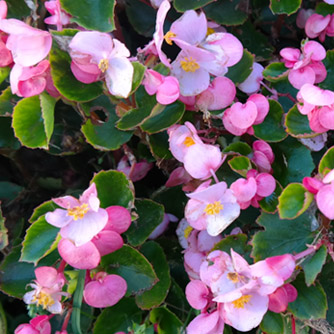
Green foliage bedding begonia
Cane begonias (Begonia coccinea)- these begonias are also called ‘angel wing’ begonias due to the shape of their leaves, which may also be spotted. They grow from distinctive strong canes and vary in height from 30cm up to 2m. During the warmer months cane begonias produce lovely hanging flowers in shades of white, pink and red. They can handle lower temperatures compared to other begonias and do best in dappled shade or morning sun with protection from hot afternoon sun.
Rex begonias (Begonia rex-cultorium) – a rhizomatous begonia type that produces amazing foliage that can be green, black, silver, red, pink, purple or metallic in combinations of swirls, splotches, spots and stripes! They do produce flowers but these are overshadowed by the impressive leaves. Rex begonias like bright shade and moist soils and grow well in pots in humid shadehouse conditions. They can be grown indoors too but need bright light and good air circulation.
Tuberous begonias (Begonia x tuber hybrida) – plants grow up to 50cm high and produce large showy flowers (singles and doubles) in a wide colour range including red, pink, orange, yellow and white. They can tolerate high temperatures but do best in cooler climates with low humidity. In spring plant tubers into pots containing a potting mix that retains moisture but still has good drainage (like African violet mix). Position pots in bright shade. Tuberous begonias flower over summer and autumn and usually require staking due to the weight of the flowers. Tubers can be lifted, dried and stored at the end of autumn when plants die down.
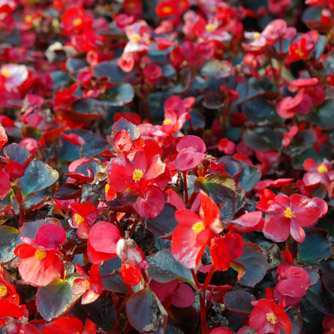
Bedding begonia with bronze foliage
Elatior begonias (Begonia x hiemalis) – another smaller growing begonia that produces heart shaped leaves and clusters of single or double flowers in shades of yellow, pink, peach, apricot and red. They are popular as an indoor plant and should be kept out of direct sunlight. Stems are easily broken and so be gentle with them. Do not over water.
There are many other beautiful begonias and some can be a bit fussy (like exotic new species). Others however are very low maintenance (like many of the new cultivars) and are definitely worth a go!
How To Grow Begonias
All begonias need protection from frost and to be planted in soil or potting mix which has good drainage. While most prefer moist soil if you over water and the soil doesn’t drain well there is a high risk of plant death. This is particularly important for begonias with tubers or rhizomes that easily rot if they stay too moist for too long.
Most begonias thrive in dappled shade or gentle morning sun with even the shade tolerant types needing bright indirect light to perform well. And just to mix things up there are a few that thrive in hot sun, like the bedding begonias! So it’s important you choose a position that has the appropriate sun/shade levels for your type of begonia.
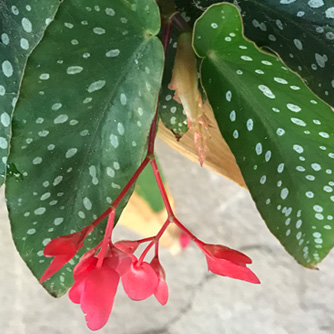
Angel wing begonia with spotted foliage
Enrich the soil with plenty of organic compost and manure. If planting in a pot or hanging basket use a good quality potting mix and then added some perlite for drainage. Avoid mixes that have water storing crystals as they will hold too much water. Once planted apply OCP eco-seaweed to reduce transplant shock and encourage strong root development.
Fertilising & Maintaining Begonias
Begonias planted in garden beds should be fed in spring, summer and autumn when they are actively growing. In warm climates you can also feed in winter. Apply a mix of aged manures, compost and/or certified organic pelletised fertiliser. You can boost this with applications of OCP eco-seaweed and OCP eco-aminogro every 2-3 weeks. This is especially useful for new plants you want to grow faster, bedding begonias, plants growing in poor soils or plants which are just not performing very well. You’ll see a rapid improvement in growth, flowering and disease resistance.
Begonias in pots can just be fed the eco-seaweed and eco-aminogro combination every 2-3 weeks during their growing period.
When it comes to watering be aware that begonias store plenty of moisture in their succulent stems and leaves. This make them vulnerable to rotting if over watered and the drainage is poor. Check moisture levels in garden beds and pots before watering. If in doubt allow potted plants to slightly dry out before watering again and try to avoid watering foliage to reduce fungal problems.
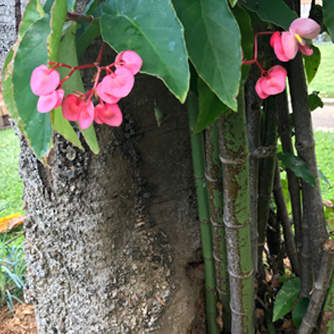
The distinctive stems of a tall growing cane begonia
Regularly remove dead and yellowing leaves and watch for early signs of fungal problems. Older canes and tired growth can be cut back in late winter to make way for vigorous spring growth.
Propagating Begonias
Begonias are easily propagated in many different ways. Here are the common methods to quickly expand your collection:
Seed – fill punnets with seed raising mix and scatter the fine seed across the top. Water in with eco-seaweed and place in a bright light position. Increased humidity will assist germination so cover with a clear plastic bag or sheet of plastic. Bedding begonias are commonly started this way.
Leaf cuttings – Most begonias grow easily from leaf cuttings and it is the common propagation method for rex begonias. Choose a healthy leaf that is free from pest and disease and make a clean cut horizontally across the main veins of the leaf. Then using small pebbles weigh the leaf down so that the cut edge makes direct contact with the potting mix. Alternatively partially bury the leaf segment (cut end down) in the potting mix. Water in with eco-seaweed and place a plastic bag over cuttings to maintain humidity. New plants will develop along the cut edge in about 8 weeks. Plant out when small plants have established.

Metallic shine on the leaves of this patterned rex begonia
Division – In spring tuberous and rhizomatous begonias can be divided and replanted into pots or directly into the garden. Apply eco-seaweed every 2 weeks to encourage root formation and growth. Maintain moisture but take care not to over water as developing plants may rot. Large clumps of cane and other begonia types can also be dug up and split into smaller sections. Late winter is best for cane types but for other plants it can done whenever they are actively growing.
Shoot cuttings – Gently prise small shoots (approx. 10cm) from tubers ensuring the small bump at base is included. Water every 2 weeks with eco-seaweed to encourage new roots to grow.
Stem cuttings – Fill a small pot with free draining potting mix and make several holes in the mix with a thin stick. Cut healthy pieces of stem about 10-15 cm long just below the junction of a leaf. Remove the lower 5-10cm leaves and place each cutting into one of the holes. Water with eco-seaweed and place in a warm, sheltered position away from direct sunlight. Keep moist and apply regular applications of eco-seaweed every 2 weeks. Stem cuttings can be taken any time of the year when the begonia is actively growing.
Cane cuttings – do the same as for stem cuttings but cuttings can be longer (approx 15-20cm). Spring or autumn are the ideal times to try. Water every 2 weeks with eco-seaweed to establish new roots.
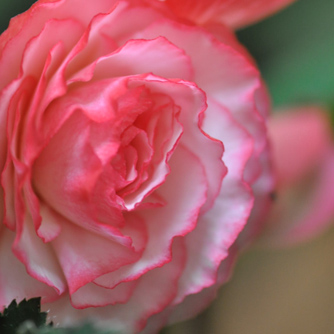
Multiple ruffled petals of a flowering double tuberous begonia
Pests and Diseases of Begonias
Begonias are often trouble free but there are a few problems watch out for:
- Aphids – new growth may occasionally attract these sap sucking pests. Spray with OCP eco-oil or OCP eco-neem for easy control.
- Caterpillars – these guys love the soft leaves of begonias. Pick off by hand or spray with OCP eco-neem.
- Snails – young seedlings are most vulnerable so keep an eye out for damage especially after rain. Sprinkle OCP eco-shield pellets around the base of the plants if required.
- Powdery mildew – this fungal disease is incredibly common on begonias and can be controlled with organic fungicides. To reduce repeat infections increase air circulation around the plant and avoid wetting leaves when watering. Regular applications of OCP eco-seaweed and OCP eco-aminogro will also build strong healthy plants with more disease resistance.
- Rot – Tuberous and rhizomatous begonias are particularly susceptible to over watering resulting in them rotting away. Allow the top centimetre of the potting mix to dry out before watering again. If unsure err on the side of less water rather than more.
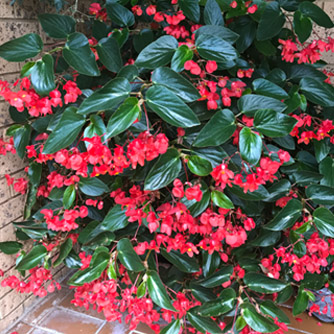
Begonia 'Dragon Wing'


